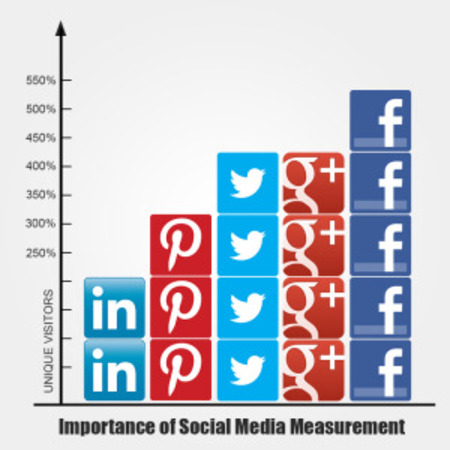- 92% of marketers say social media is important to their business (Social Media Examiner)
- 73% plan to increase spending on marketing analytics (The CMO Survey)
- Only 42% are able to measure their social activities (Social Media Examiner)
If social media is so important, why are most marketers unable to measure it? Do they need to know the social media metrics that matter and how they are monitored?
Here are the top 14 social media metrics and the tools to track them.
- KEYWORDS: Smart keywords choices and placement on social networks give your brand a better chance of being found. Consumers that are exposed to a brand on social media are 180% more likely to search for that brand on search engines according to a Group M study. Google Trends and the Google Keyword Planner are two tools to use; the former identifies keywords that people are searching with increasing search interest and the latter provides their monthly keyword volume.
- INBOUND LINKS: Social media links from blog posts and social posts are another primary means of raising social and search presence. These come from blog posts and social posts. Track the number of links pointing to your website and/or blog, and examine the source of new links. Open Site Explorer from SEOmoz and bit.ly are great inbound tracking services. They are also free if that’s any additional motivation.
- SERP (SEARCH ENGINE RESULTS PAGE): Social network pages are web pages too. If search interest is increasing, social networks show up in search results doubling or tripling chances of being found. The more entries there are the better, especially in high-ranking positions. What’s My SERP has SERP Checker that’s easy to use. Tracking SERP is an important way to see progress.
- REACH: Reach is the potential audience for a message based on total follower count (Twitter, Pinterest and LinkedIn followers, total Likes on your Facebook page). If your boards have 1,000 followers on Pinterest, then each of your pins could potentially reach 1,000 people. Facebook considers a post reaches someone when it’s shown in that person’s News Feed. Through Facebook Insights, Facebook provides “total reach,” which includes the number of unique people who saw any activity from a Page as well as paid vs. organic reach.
- ENGAGEMENT: Actions such as Like, Share, Comment, ReTweet and Favorite measures how much and how often others interact with you and your content in social media. Radian6 and SimplyMeasured are tools that show the percentage of people reached who engage in your content, how they respond and the differences by social network.
- SHARE OF VOICE: Reach and Engagement are important to know not only about your brand but your competitors. Quite often, a smaller brand with a lower level of Reach can distinguish itself by displaying a higher level of Engagement to the benefit of their business.
- SENTIMENT: A “Sentiment Analysis” tells you if the people who comments are saying positive, negative or neutral things. It’s done by computer for each social network and expressed as a ratio of positive/negative. A “Sentiment Analysis” provides direction for your communications strategy. Social-Searcher has excellent social analytics, including “Sentiment Analysis,” anyone can use.
- COST PER CLICK (CPC): If you’re paying for ads, the measurement that makes them equivalent is Cost Per Click (CPC). It helps to have a value in mind. CPC also lets you know what others are willing to pay. CPC helps determine what the cost of a conversion is and the return on the ad investment (ROAI).
- CLICK THROUGH RATE (CTR): The relevance of your ad is determined by its Click Through Rate; that is, the number of clicks divided by impression or screens it is seen each time the ad is served. An ad buy on any social network shows the CPCs and CTRs.
- VISITS/UNIQUE VISITORS: According to Shareaholic, Facebook now drives 23% of referral traffic to a website. It’s important to know just how much traffic is coming to a website from people who have gotten to know you on social networks. This is easy to see from Google Analytics, perhaps the best social media measurement tool of them all. Use Google Analytics to measure the remaining top metrics (11-14) on this list.
- BOUNCE RATE: The percent of people who get to your website, view one page and leave is the Bounce Rate. It’s considered one of the best metrics to gauge a website’s relevance. It’s a key metric to know in general and to compare to the Bounce Rate of those who come from social networks.
- TRAFFIC SOURCES: The percent of people who come to your website from social networks can be easily found in Google Analytics. People like to business with people they know. Traffic Sources are a primary indicator if social media efforts are succeeding in sending people to your website.
- KEY CONTENT: Once consumers are on your website, you’ll want to know where they go. Look at Key Content to find out their areas of interest and to get ideas for content to communicate on social networks.
- CONVERSIONS: The metric that has the highest business value and relates most directly to return on investment (ROI) is Conversions. This is defined as the desired outcome (buy, download, view, subscribe) divided by Visits. Because Conversions are so important, there may be more than one. The one that is closest to direct revenue is the Macro Conversion; others that lead Macro Conversion are called Micro Conversion. Together, they define buying behaviors for your brand.
To help you know the best days of the week and time of day to publish your content on social network and maximize success, here is an article from Nora Flint at TruConversion to guide you.
Did this show you what metrics matter in social media and how to measure them? Do your business need a measurement strategy and plan to help manage social media success?

